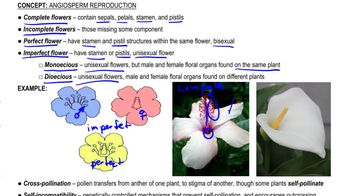Evaluate this statement: Species want to increase their fitness by helping friendly species and hurting enemy species.
Table of contents
- 1. Introduction to Biology2h 42m
- 2. Chemistry3h 40m
- 3. Water1h 26m
- 4. Biomolecules2h 23m
- 5. Cell Components2h 26m
- 6. The Membrane2h 31m
- 7. Energy and Metabolism2h 0m
- 8. Respiration2h 40m
- 9. Photosynthesis2h 49m
- 10. Cell Signaling59m
- 11. Cell Division2h 47m
- 12. Meiosis2h 0m
- 13. Mendelian Genetics4h 44m
- Introduction to Mendel's Experiments7m
- Genotype vs. Phenotype17m
- Punnett Squares13m
- Mendel's Experiments26m
- Mendel's Laws18m
- Monohybrid Crosses19m
- Test Crosses14m
- Dihybrid Crosses20m
- Punnett Square Probability26m
- Incomplete Dominance vs. Codominance20m
- Epistasis7m
- Non-Mendelian Genetics12m
- Pedigrees6m
- Autosomal Inheritance21m
- Sex-Linked Inheritance43m
- X-Inactivation9m
- 14. DNA Synthesis2h 27m
- 15. Gene Expression3h 20m
- 16. Regulation of Expression3h 31m
- Introduction to Regulation of Gene Expression13m
- Prokaryotic Gene Regulation via Operons27m
- The Lac Operon21m
- Glucose's Impact on Lac Operon25m
- The Trp Operon20m
- Review of the Lac Operon & Trp Operon11m
- Introduction to Eukaryotic Gene Regulation9m
- Eukaryotic Chromatin Modifications16m
- Eukaryotic Transcriptional Control22m
- Eukaryotic Post-Transcriptional Regulation28m
- Eukaryotic Post-Translational Regulation13m
- 17. Viruses37m
- 18. Biotechnology2h 58m
- 19. Genomics17m
- 20. Development1h 5m
- 21. Evolution3h 1m
- 22. Evolution of Populations3h 53m
- 23. Speciation1h 37m
- 24. History of Life on Earth2h 6m
- 25. Phylogeny2h 31m
- 26. Prokaryotes4h 59m
- 27. Protists1h 12m
- 28. Plants1h 22m
- 29. Fungi36m
- 30. Overview of Animals34m
- 31. Invertebrates1h 2m
- 32. Vertebrates50m
- 33. Plant Anatomy1h 3m
- 34. Vascular Plant Transport1h 2m
- 35. Soil37m
- 36. Plant Reproduction47m
- 37. Plant Sensation and Response1h 9m
- 38. Animal Form and Function1h 19m
- 39. Digestive System1h 10m
- 40. Circulatory System1h 49m
- 41. Immune System1h 12m
- 42. Osmoregulation and Excretion50m
- 43. Endocrine System1h 4m
- 44. Animal Reproduction1h 2m
- 45. Nervous System1h 55m
- 46. Sensory Systems46m
- 47. Muscle Systems23m
- 48. Ecology3h 11m
- Introduction to Ecology20m
- Biogeography14m
- Earth's Climate Patterns50m
- Introduction to Terrestrial Biomes10m
- Terrestrial Biomes: Near Equator13m
- Terrestrial Biomes: Temperate Regions10m
- Terrestrial Biomes: Northern Regions15m
- Introduction to Aquatic Biomes27m
- Freshwater Aquatic Biomes14m
- Marine Aquatic Biomes13m
- 49. Animal Behavior28m
- 50. Population Ecology3h 41m
- Introduction to Population Ecology28m
- Population Sampling Methods23m
- Life History12m
- Population Demography17m
- Factors Limiting Population Growth14m
- Introduction to Population Growth Models22m
- Linear Population Growth6m
- Exponential Population Growth29m
- Logistic Population Growth32m
- r/K Selection10m
- The Human Population22m
- 51. Community Ecology2h 46m
- Introduction to Community Ecology2m
- Introduction to Community Interactions9m
- Community Interactions: Competition (-/-)38m
- Community Interactions: Exploitation (+/-)23m
- Community Interactions: Mutualism (+/+) & Commensalism (+/0)9m
- Community Structure35m
- Community Dynamics26m
- Geographic Impact on Communities21m
- 52. Ecosystems2h 36m
- 53. Conservation Biology24m
51. Community Ecology
Introduction to Community Interactions
Problem 11
Textbook Question
How do animals help flowering plants reproduce? How do the animals benefit?
 Verified step by step guidance
Verified step by step guidance1
Understand the concept of mutualism: Mutualism is a type of symbiotic relationship where both organisms involved benefit. In this case, animals and flowering plants have a mutualistic relationship during reproduction.
Learn about pollination: Animals such as bees, butterflies, birds, and bats help flowering plants reproduce by transferring pollen from the male structures (anthers) of one flower to the female structures (stigma) of another flower. This process is essential for fertilization and the production of seeds.
Explore how animals benefit: Animals benefit from this interaction by obtaining food, such as nectar or pollen, from the flowers. Nectar is a sugary liquid that provides energy, while pollen can be a source of protein.
Understand seed dispersal: Some animals also help flowering plants by dispersing seeds. For example, animals may eat fruits and later excrete the seeds in a different location, aiding in the spread of the plant species.
Recognize the ecological importance: This mutualistic relationship is crucial for maintaining biodiversity and ecosystem stability, as it ensures the survival and reproduction of both plants and animals.
 Verified video answer for a similar problem:
Verified video answer for a similar problem:This video solution was recommended by our tutors as helpful for the problem above
Video duration:
2mPlay a video:
Was this helpful?
Key Concepts
Here are the essential concepts you must grasp in order to answer the question correctly.
Pollination
Pollination is the process by which pollen from the male part of a flower (anther) is transferred to the female part (stigma). Animals, particularly insects like bees and butterflies, play a crucial role in this process by moving pollen as they feed on nectar. This interaction not only facilitates the fertilization of plants but also enhances genetic diversity among plant populations.
Recommended video:
Guided course

Pollination
Mutualism
Mutualism is a type of symbiotic relationship where both species involved benefit from the interaction. In the context of flowering plants and animals, plants provide food resources, such as nectar and pollen, while animals assist in the plant's reproduction by pollinating flowers. This relationship is essential for the survival and reproduction of many plant species and supports biodiversity.
Recommended video:
Guided course

Positive Interactions
Seed Dispersal
Seed dispersal is the process by which seeds are spread away from the parent plant to reduce competition and promote colonization of new areas. Animals contribute to this process by consuming fruits and excreting the seeds at different locations. This not only aids in the propagation of flowering plants but also allows animals to benefit from the nutritional value of the fruits.
Recommended video:
Guided course

Seed Plants - 1

 1:57m
1:57mWatch next
Master Introduction to Community Interactions with a bite sized video explanation from Jason
Start learningRelated Videos
Related Practice
Textbook Question
593
views
